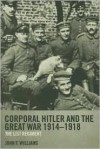Currently reading
Gabriela, Cravo e Canela
Progress:
157/358 pages
Seven Pillars of Wisdom: A Triumph (The Authorized Doubleday/Doran Edition)
Progress:
189/672 pages
The Creature from Jekyll Island: A Second Look at the Federal Reserve
Progress:
41/608 pages
Peter the Great
Progress:
472/934 pages
Under the Loving Care of the Fatherly Leader: North Korea and the Kim Dynasty
A Time for Trumpets: The Untold Story of the Battle of the Bulge
Progress:
191/712 pages
The German Army 1933-1945
Progress:
198/598 pages
Corporal Hitler and the Great War 1914-1918: The List Regiment
Progress:
22/238 pages
 Given the paucity of information about the fighter aces who flew with the Austro-Hungarian Empire (Army & Navy) during the First World War, this book provides an interesting view of how military aviation in that nation acquitted itself on the various fighting fronts.
Given the paucity of information about the fighter aces who flew with the Austro-Hungarian Empire (Army & Navy) during the First World War, this book provides an interesting view of how military aviation in that nation acquitted itself on the various fighting fronts. In contrast to Germany, France, Italy, and Britain, whose aviation industries under the impetus of war expanded and produced in excess of 100,000 military aircraft, only 4,768 aircraft were approved for use by the Austro-Hungarian military (the Luftfahrtruppen, LFT). Indeed, "[f]rom the beginning of the war, local aviation manufacturers had wasted already scarce resources on ill-conceived projects, and they ... lacked the skilled workers and raw materials to build new aeroplanes. They were also unable [in the last months of the war as Austria-Hungary faced the prospect of scarcer raw materials and foodstuffs owing to the tighter constraints of the longstanding British naval blockade] to send spare parts, fuel and even paint and bracing wires to the front. This left Austro-Hungarian airmen with little option but to bear their pain and continue to fight and die without hope, fully aware of the futility of their sacrifice."
The book also has a beautiful set of photographs and colored illustrations of the Albatros fighter used by some of Austria-Hungary's top aces. That, in itself, makes "Austro-Hungarian Albatros Aces of World War 1" a worthy addition to any aviation aficionado's library.













